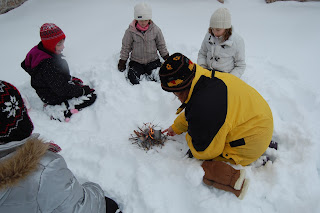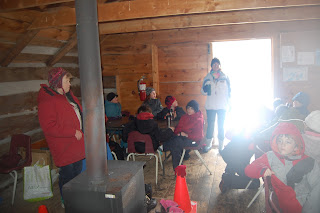Our volunteer naturalist Heather Lunn led a fantastic program, which started with the kids dividing into two groups and visiting four different bird-related stations. Heather's station dealt with identifying birds in winter. She brought several pictures and guides and situated the group in some edge habitat (where the field meets the edge of the forest) to talk about the four main birds that stay at Murphys Point in winter: ruffed grouse, great horned owl, downy woodpecker and black-capped chickadee. She played bird calls and talked about other ways to identify them, such as visual cues.

Volunteer Judy Buehler, another outdoor enthusiast and birder, conducted the next station, which focused on backyard bird feeding. Several different feeders were set up in the big pine tree behind the Lally Homestead. Judy showed the group different food for birds, such as suet and seeds, and discussed the best ways to feed birds in the backyard - from favourite foods to good locations. Then the kids made Cheerio-bird-feeding necklaces that they could take home and hang on a tree for the birds.

Volunteer Pat Batchelor led the group on a short hike along the Lally Trail to discuss winter homes and habitats for birds. First they discussed good homes for birds that stay in winter and demonstrated different bird boxes. Each participant received a map of the Lally Trail with a clipboard and stickers. As they went along the trail they identified good homes and food sources for birds, and marked them on the map with the stickers.




The last station was led by Steph Gray and Linda McLaren and consisted of a winter survival game in the field. After a discussion about what birds need to survive in winter (food, water and shelter), one participant was designated to be a great horned owl and the rest were red cardinals. The cardinals had to collect a scoop of seeds from a bucket at one end of the field and deliver it "home" to an empty bucket, then do the same with a scoop of water and a tree branch to represent shelter. Anyone who collected all three items without being tagged was a true survivor!


The grand finale took place in the homestead with special guests Dwayne Struthers and Garnet Baker from the Leeds County Stewardship Council, along with Jeff Ward from the Lanark County Stewardship Council. Dwayne and Garnet led a session on bluebird box building, and came with kits for the kids to use so that they could each assemble a box to take home!

The kits contained pre-cut wood and pre-drilled holes, and the participants had the chance to line everything up and use a screwdriver to put everything together. Each box is made so that one side that swings open so the box can be cleaned out each year. The boxes should be fastened to a post (ideally steel so predators can't climb up) at least one metre above the ground. Dwayne and Garnet explained that not every box will attract a bluebird, but they should attract some kind of bird, such as swallows. An installation and care sheet will be provided to the kids with their workbook pages at the end of the program.




While the participants worked on the boxes they nibbled on a delicious snack provided by Skipper Linda McLaren - apples, juice and "seedy" cookies.
A huge thank you to Dwayne and Garnet for providing their skills, expertise and supplies for the bluebird boxes; to Heather for leading this week's program and to all of our program volunteers: Linda, Pat, Judy and Steph. Next week we look forward to communing with the trees - possibly on snowshoes!












































